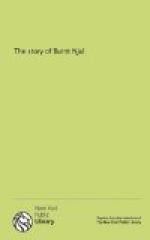foul deed, and Kurt’s stern revenge. We
may be sure that as soon as each event recorded in
the Saga occurred, it was told and talked about as
matter of history, and when at last the whole story
was unfolded and took shape, and centred round Njal,
that it was handed down from father to son, as truthfully
and faithfully as could ever be the case with any
public or notorious matter in local history. But
it is not on Njala alone that we have to rely for
our evidence of its genuineness. There are many
other Sagas relating to the same period, and handed
down in like manner, in which the actors in our Saga
are incidentally mentioned by name, and in which the
deeds recorded of them are corroborated. They
are mentioned also in songs and Annals, the latter
being the earliest written records which belong to
the history of the island, while the former were more
easily remembered, from the construction of the verse.
Much passes for history in other lands on far slighter
grounds, and many a story in Thucydides or Tacitus,
or even in Clarendon or Hume, is believed on evidence
not one-tenth part so trustworthy as that which supports
the narratives of these Icelandic story-tellers of
the eleventh century. That with occurrences of
undoubted truth, and minute particularity as to time
and place, as to dates and distance, are intermingled
wild superstitions on several occasions, will startle
no reader of the smallest judgment. All ages,
our own not excepted, have their superstitions, and
to suppose that a story told in the eleventh century,—when
phantoms, and ghosts, and wraiths, were implicitly
believed in, and when dreams, and warnings, and tokens,
were part of every man’s creed—should
be wanting in these marks of genuineness, is simply
to require that one great proof of its truthfulness
should be wanting, and that, in order to suit the spirit
of our age, it should lack something which was part
and parcel of popular belief in the age to which it
belonged. To a thoughtful mind, therefore, such
stories as that of Swan’s witchcraft, Gunnar’s
song in his cairn, the Wolf’s ride before the
Burning, Flosi’s dream, the signs and tokens
before Brian’s battle, and even Njal’s
weird foresight, on which the whole story hangs, will
be regarded as proofs rather for than against its
genuineness.[3]
But it is an old saying, that a story never loses
in telling, and so we may expect it must have been
with this story. For the facts which the Saga-teller
related he was bound to follow the narrations of those
who had gone before him, and if he swerved to or fro
in this respect, public opinion and notorious fame
was there to check and contradict him.[4] But the
way in which he told the facts was his own, and thus
it comes that some Sagas are better told than others,
as the feeling and power of the narrator were above
those of others. To tell a story truthfully was
what was looked for from all men in those days; but
to tell it properly and gracefully, and so to clothe
the facts in fitting diction, was given to few, and
of those few the Saga teller who first threw Njala
into its present shape, was one of the first and foremost.




